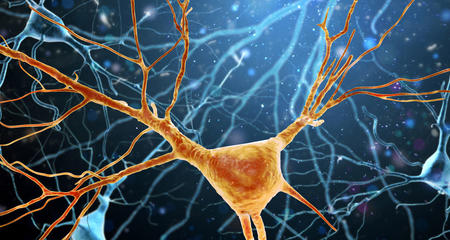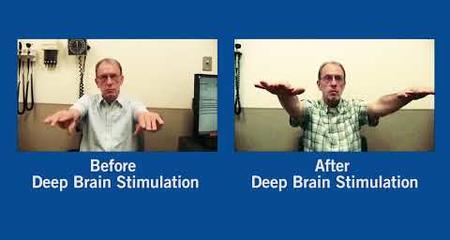Movement disorders are neurological conditions that affect a person’s ability to control the way his or her body moves. Symptoms are progressive and develop slowly over years. Symptoms for Parkinson’s disease and other movement disorders differ from person to person.
The Froedtert & MCW Parkinson's Disease and Movement Disorders Program offers the broadest range of care options available in the region — helping people with movement disorders cope with physical symptoms, emotional issues, social stigmas and other concerns related to these disorders.
There are four major symptoms of Parkinson's disease that affect motor skills. Tremors, stiffness and slowness can cause difficulty with handwriting and other fine motor skills.
- Resting tremors
- Rigidity (stiffness)
- Bradykinesia (slowness of movement)
- Gait and balance problems
Movement disorders can also cause other nonmotor issues such as:
- Anxiety, depression and stress
- Cognitive changes
- Constipation and nausea
- Dementia
- Fatigue
- Hallucinations/delusions
- Lightheadedness due to drop in blood pressure
- Loss of smell
- Pain
- Sleep disorders
- Speech, voice and swallowing problems
- Vision problem
-
Anxiety, Depression and Stress
It is estimated that up to half of people with movement disorders experience depression during their illness. Most have minor depression. Sometimes, depression is the first symptom of Parkinson’s disease. Major depression occurs in about 5 to 10% of cases.
Both psychological and biological factors are involved. Often, patients will experience a psychological reaction to having a chronic illness. It is also possible that, just as the loss of dopamine affects movement, that loss (along with the changes in serotonin and norepinephrine) can cause chemical or biological depression.
Your neurologist will ask about your mood, interests, sleep and appetite and fatigue — all indicators for depression. Antidepressants are used commonly to help patients who suffer from depression. Psychotherapy can also be effective as can complementary treatment options — support groups, exercise, music therapy, massage and other options.
Anxiety leads to stress. Anxiety is created by your thoughts. You may think people are staring at you. You think you may become “frozen” or are too slow in line at the grocery store. You think about the progression of diagnosis and worry about the future for you and your family. Stress will make your symptoms worse.
You have the power to change your thoughts, reduce anxiety and limit stress. Stress reduction might mean you can get by with lower doses or less medication. It will certainly improve your quality of life.
Meditation, relaxation techniques, massage and guided imagery are some ways to reduce anxiety and, therefore, reduce stress. Physical exercise that includes walking and some form of balance/stretching work (e.g., fundamental yoga or Tai Chi) has a direct impact on the motor symptoms, as well as stress and anxiety levels.
We can provide resources for exercise and complementary medical practices. In some cases, patients may need to meet with a clinical psychologist or a psychiatrist for stress and anxiety issues.
-
Lightheadedness Due to Falling Blood Pressure
Orthostatic hypotension or “orthostasis” is caused by dysfunction in the autonomic nervous system. This part of the nervous system is responsible for various automatic functions in your body, such as your heartbeat, breathing, perspiration and blood pressure.
Some people with Parkinson’s disease have problems with falling blood pressure when going from a sitting to standing position. That’s why the movement disorder neurologist takes your blood pressure reading from both positions. A rapid drop in blood pressure will cause lightheadedness and the possibility of passing out or falling. Parkinson’s disease medications can make orthostasis worse.
If orthostatis isn’t too severe, it can sometimes be treated with a simple increase in salt intake. Your neurologist must analyze your condition, taking into account all your medications and the severity of your blood pressure drop. If you suffer from lightheadedness when you stand, or if you’ve ever passed out or fallen when you rise from a chair, be sure to inform your neurologist.
-
Vision Problems
The same nerve disturbances that cause tremors can lead to a number of vision problems.
Difficulty Reading
After common problems such as cataracts and macular degeneration have been ruled out, it can be helpful to evaluate a patient’s ability to shift the eyes from the distant to the near. This evaluation may reveal that your capacity for converging eye movements is reduced. Convergence insufficiency makes it difficult to keep both eyes pointed together at a near target.
This is one of the most common eye movement disorders. People may only complain of eye strain while they read, but more pronounced symptoms may appear, including a reduced ability to read, eye fatigue and sometimes double vision or a tendency to involuntarily close one eye while reading.
Convergence insufficiency, when identified as a cause of reading problems, may be improved with exercises designed to strengthen eye movements (the turning motion of the eyes toward or away from each other). In many cases, however, this will not be enough, and improving near vision may require the use of prisms in dedicated reading glasses.
Prisms are optical devices that can be ground into regular eyeglasses. They bend the light so that the amount of convergence necessary for near vision is reduced. In severe cases, however, even this may not provide adequate relief, and the only remaining option is to cover one eye with a patch or cover glasses with occluding tape so the patient only reads with one eye.
Reduced Blinking and Eye Movement Disturbances
Other eye movement disturbances have been described in Parkinson's disease patients. These include an impaired ability to pursue a moving target with the eyes, difficulty initiating gaze shifts or taking the eyes off a face. Also, the ability to maintain eccentric gaze is impaired, and the blink frequency tends to be reduced. Of these abnormalities, only the latter tends to show significant symptoms, as reduced blinking can cause a feeling of dry eyes. This may be further enhanced by reduction in tear secretion, which is also common in Parkinson's disease. Management of dry eyes usually involves the use of artificial tears. It is rare that you'll need any additional treatment to combat symptoms of dry eyes.
Patients with Parkinson's disease are also susceptible to visual hallucinations. These can be related to the underlying neurological illness or medications used for treatment. PD patients who have visual hallucinations respond well to antipsychotic medications such as quetiapine. Hallucinations should always be reported to the physician.
Vision Problems With PSP (Progressive Supranuclear Palsy)
Slowness in looking up or down when moving the head is a symptom in a rare type of Parkinson's disease called progressive supranuclear palsy (PSP). Patients with PSP have trouble initiating gaze shifts in the up and downward direction, and the speed and extent of such gaze shifts reduce as the disease progresses.
The negative effects on vision and visual orientation are profound. Patients can eventually lose their ability to look down through the reading part of their glasses, causing an inability to read. In addition, they become susceptible to falls by not seeing where they step on level ground or on stairs. This adds greatly to mobility and balance problems, which are already prominent with PSP.
Unfortunately, there is no treatment for this eye movement disorder. To make reading easier, special reading glasses that cover the entire field of vision can be prescribed, and reading material may have to be placed at eye level in a special stand.
-
Speaking and Swallowing Issues
Most people with movement disorders will experience changes in speech, voice and swallowing at some point in their disease. The same PD symptoms that occur in the muscles of the body — tremor, stiffness and slow movement — can occur in the muscles used for speaking and swallowing. This can cause:
-
A soft voice
Mumbled or fast speech
Loss of facial expression
Problems communicating
Trouble swallowingWhile medications help improve most symptoms, they are not as helpful with improving speech and swallowing problems. Most people have the most improvement with speech and swallowing when medications are paired with a speech therapy program.
Ongoing research into a speech therapy program known as the Lee Silverman Voice Treatment® (LSVT) method is funded by the National Institutes of Health and the U.S. Office of Education. The LSVT method is effective in improving voice and speech in persons with PD. Froedtert & the Medical College of Wisconsin have speech-language pathologists certified in LSVT, and our movement disorder neurologists often refer patients for this therapy. Early intervention is key to maintaining and improving communication and swallowing function.
Collagen injections have been used in the treatment of voice and/or speech impairment. The purpose of the injections is to build up vocal folds that do not close completely while talking. Ask your movement disorder neurologist if you are a candidate for this procedure.
Managing the Symptoms
Members of your movement disorders team will work with you to determine what treatment is best for you. Options include:
- Medications
- Non-medications treatments such as exercise, lifestyle changes and therapy
- Surgical options
Support and a connection to resources for patients and family members are also important components of our program. Resources are aimed at improving health and wellbeing through all stages of a movement disorder.
Virtual Visits Are Available
Safe and convenient virtual visits by video let you get the care you need via a mobile device, tablet or computer wherever you are. We'll assess your condition and develop a treatment plan right away. To schedule a virtual visit, call 414-777-7700.
More to Explore





